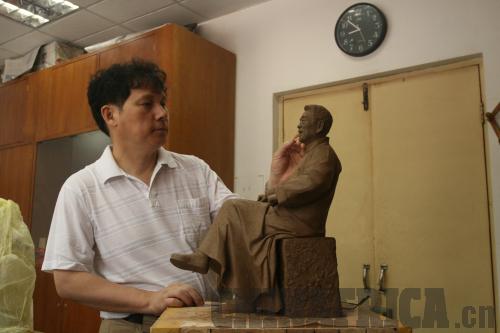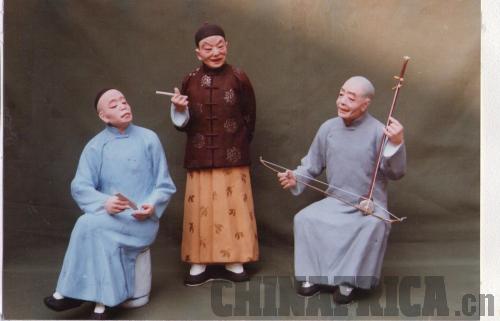| 
Zhang Mingshan's works gain favor from the royal family of the Qing Dynasty
Over 180 years ago, a craftsman named Zhang Mingshan came to prominence in northChina'sTianjin for his colorful clay figurines. Zhang's work became so celebrated that he gained favor from the royal family of the Qing Dynasty (1644-1911), who decided to decorate the royal palace with his work. At the time, the best craftsmen in the country were sponsored by the stateand separated from the business world, so throughout his life most of Zhang's pieces went to the palace or to friends; few were sold for profit.
But in today'sChina, Zhang's successors, who inherited his techniques as well as the renowned brand named after him, Clay Figure Zhang, must take business as a primary concern and find a place for their 100-year-old business in the world's fastest developing economy.
Findings of the third national survey on cultural heritage, conducted from 2007 to 2011, show thatChinais home to around 870,000 intangible cultural heritages which include folk music, drama, skills and crafts. The survey states that up to 2010, the governments at all levels had invested 1.8 billion yuan ($300 million) in preservation. Despite this massive sum, many ofChina's cultural heritages, like the Clay Figure Zhang brand, struggle to survive.

Clay Figure Zhang features colorful clay figurines
Tricky balance
For the Clay Figure Zhang brand, the hardest time was in the 1980s, when its store was rarely visited and had to eke out an existence through selling toys and costumes. This experience was dramatic but by no means exclusive. At the time, many folk art troupes and studios endured similar dilemmas, with some still scrambling for revenue today. Few talented youth would like to devote their life to an art so out of fashion and unprofitable, so traditional techniques are fading without enthusiastic successors.
In recent years, some scholars have argued that the future of folk arts and cultural heritages lies in industrialization, which could help craftsmen and artists stand on their own feet. On the other hand, many critics argue that adding a commercial touch would ruin the long-cherished arts.
While the debate rages, some cultural heritage businesses have managed to scrape by. Clay Figure Zhang, for instance, now runs three stores with an annual sales revenue of 12 million yuan ($2 million). Zhang Yusheng, an artist who has worked at Clay Figure Zhang for 35 years, believes that the key to success is to reach a delicate balance between art and business.
Zhang attributed the slump in the history of Clay Figure Zhang to a misunderstanding of business principles.
"At that time, we believed that art should serve business, the more copies of old designs we made, the more successful business we can achieve," Zhang said. "But all art professionals should know that the truth is the opposite: the more you create, the better your business gets."
Occupied with repeating and copying, the artists were left no time or space to think and create valuable new ideas and artwork.
"What we produced [felt] just like fast food, but what the market needs is the products with more inside. When art serves business only, it will finally lose the market," Zhang said.
Today, the studio adopts a relaxed working style. The artists on staff are given more space to work on their own designs. Their delicate artistic works are offered to high-spenders while stores catering to tourists are stocked with affordable clay figurines of mass production.

Zhang Mingshan's works gain favor from the royal family of the Qing Dynasty
Branding
Complicating matters for businesses involved in the cultural heritage industry is that they need to worry about more than just their own development. Well-respected historical brands attract a lot of knock-off manufacturers and individual copycats, mostly assembled in the souvenir stores in tourism spots. This can lead to a negative first impression for people from all around the country and abroad who encounter these fake artworks and are duped into thinking the real ones are just as shoddy.
According to Zhang, there are more than 10 factories inTianjinproducing low-quality reproductions of Clay Figure Zhang works. But he understands why they exist and even sees them as necessary. "It may affect our reputation. But when we still need to make ourselves known by more people, at some degree they might be helpful. The target market of folk culture is still quite small. We cannot rely on the high-spenders alone to influence mass market."
He believes that time is needed for traditional arts to explore the market and for the inferior or shoddy products to be washed out. During the process, artists will feel encouraged to be more creative in order to keep their work distinct from mass produced ones.
Although the Clay Figure Zhang brand is generally lenient toward reproduction, it is vigilant in protecting its brand value as demonstrated by a seven-year legal struggle. In 2005, Zhang Mingshan's Clay Figure Zhang based inTianjinsued Zhang Tiecheng, a famous craftsman based inBeijingwho has run and registered his business under the Clay Figure Zhang name and has become well-known for it by locals.
The case was extremely bitter and drew great attention due to the fame of the 100-year-old Clay Figure Zhang brand. Finally, the courts decided in favor of Zhang Mingshan, and the original Clay Figure Zhang finally won its name back on February 28, 2012.
In September 2013, Clay Figure Zhang held an exhibition in the National Art Museum of China based inBeijing, six decades after it last staged an exhibition there in the 1960s.
|